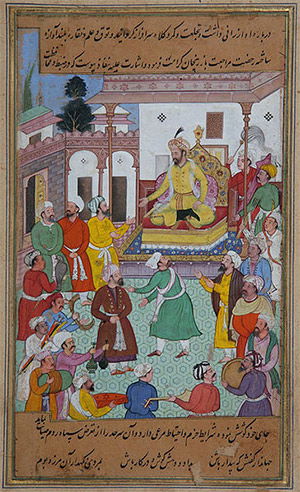The Sack of Damascus
Timur's army attacked the ancient town on 24 March 1401.

The central character of Christopher Marlowe’s bloodthirsty and hugely popular drama Tamburlaine the Great, in which the fall of Damascus is a major episode, was the savage Turkic warlord the Persians called Timur Lenk (Timur the Lame), which in English became Tamburlaine or Tamerlane.
One of history’s more notorious psychopaths, Timur began his career as a bandit in what is now Uzbekistan. By his thirties he had made himself ruler of the Chagatai Khanate with his capital at Samarkand. Ruthless, cunning, vengeful and cruel, he announced himself the restorer of the Mongol Empire, though his campaigns were more in the nature of large-scale looting expeditions than empire-building. In the 1380s and ‘90s he and his horsemen invaded Russia and Persia, ravaged Azerbaijan, Armenia, Georgia, Iraq and Mesopotamia, and smashed the Golden Horde. Pillage and murder, as Marlowe put it, were Timur’s ‘usual trades’. Everywhere he went, he waded deep in blood and brains, destroying cities and massacring their populations, building triumphal towers of his victims’ severed heads and carrying off survivors as slaves. In 1398 he invaded India, crossing the Indus on a bridge of boats, reducing Delhi to rubble and taking away enormous quantities of the plunder on which his army’s loyalty depended.
Tall and powerfully built, lamed in his youth by an enemy arrow in his right leg, Timur was reputedly a fine chess player and enjoyed a good theological discussion as well as food, drink and women in quantity. His last major campaign was aimed against the Ottoman Sultan, Bayazid I, and the Mameluke sultan of Egypt. Invading Syria, he took Aleppo and sacked it, and descended on the ancient and civilised town of Damascus, the second city of the Mameluke Empire, whose garrison had already been virtually wiped out in a rash sortie. The governor held out with some forty men in the citadel, but surrendered after a month. Timur extorted a huge ransom from the town and then let his men loose to rape and pillage. Many of the inhabitants were viciously tortured, bastinadoed, burned or crushed in presses, and many were enslaved. Children under five were left to starve when their mothers were carried off. One of those enslaved was the twelve-year-old Ahmad ibn Arabshah, who later wrote a biography of Timur. As was his habit, Timur had all the town’s skilled craftsmen deported to Samarkand to beautify his capital.
Timur went on to take Baghdad by storm, rout Bayazid’s army near Ankara in 1402 and take the sultan prisoner. He launched a campaign against China in 1404, but fell ill and died early in the following year. His body was taken back to Samarkand for burial, but according to Ahmad ibn Arabshah, ‘he was carried to the cursing and punishment of God, remaining in torment and God’s infernal punishment.’




